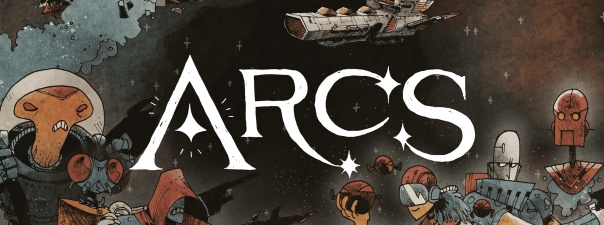Arcs Supra Arcs
Arcs is the most lucid title Cole Wehrle has created — and that’s speaking for someone whose ludography is packed with crisp thesis statements. It’s come such a long way in the two years since I previewed the prototype that there’s really no point drawing comparisons. The obvious lodestar is Oath; like that game, Arcs exhibits the long, ahem, arc of history, the way identities and meanings weather or buckle under the weight of time. But Arcs is the more resolute of the two, a game built as much on hindsight as with the benefit of additional years of experience.
It is sublime. It’s also a difficult game to pin down, arrayed like a blossom. Let’s start with the stem.
Corpse of Discovery
I don’t read comics, or at least that used to be the case. While I still don’t count myself an enthusiast, Mind MGMT, the inaugural title by Off the Page Games, introduced me to Matt Kindt’s series of the same name — and a wider world of comics than I had previously known existed. Harrow County, the imprint’s second effort, didn’t spark my affection quite so thoroughly, but that’s a tall bar to clear.
Now Jay Cormier and Sen-Foong Lim are back at it. This time they’re tackling a brutal comic series by Chris Dingess and Matthew Roberts called Manifest Destiny. In a wise marketing move, Cormier and Lim have switched the title to Corps of Discovery — it’s pronounced “core,” lest the headline lead you astray — and mechanically, it’s one of the most enthralling cooperative games I’ve played in ages. I’m of two minds about it.
Vampire/Werewolf/Witch/Demon Village
Vampire Village is not about building a village for vampires — and thank goodness, after the blandness that was SiliconVania. Instead, it whisks us to exotic Central Europe, where the crossroads of the west have attracted a veritable convention of vampires, werewolves, witches, and demons to feast on the citizens of your hamlet. Not the best spot for a thriving community, but the schools were good. Designed by Maxime Rambourg, half of the team behind The Loop, it’s a hate-drafting game with surprising bite.
Daunted: Battle of Britain
Trevor Benjamin and David Thompson’s Undaunted has grown storied over the past half-decade, crossing the beaches of Normandy, the sands of North Africa, and most recently the besieged city of Stalingrad. That last installment proved one of my favorite light wargame experiences of all time, a grueling and personal perspective on the Second World War’s turning point.
Now the series’ fourth major installment is taking us to the skies. I’m trying to decide whether the letdown it fills me with is thanks to the furious pitch and ambitious quality of Stalingrad or because this system is ill-suited to what Battle of Britain is trying to accomplish.
Fartlings
Sometimes I wonder whether I’ve become a grouchy old man or if some things really are this vacuous. Probably the former.
Doomlings occupies its own corner of the tabletop hobby. It’s a corner I don’t often step into. Boxes covered with cutesy but off-putting caricatures, possibly with foil highlights that glint like neon signs announcing the inclusion of cable TV at that one motel on the edge of town that’s always clashing with the health department. Artwork either drawn by or drawn in imitation of Matthew Inman, the guy who writes The Oatmeal and inflicted Exploding Kittens and its offspring on the world. These are the board games that board game stores are required by law to carry. They sell them to your grandmother when she wanders over, befoiled box in hand, to proudly announce that her grandchildren love board games. This one caught her eye, some part of her mammalian cortex screaming in recognition at the box’s combination of glinting eyes, thirsty smiles, and bulging forms. In caveman times, she would have recognized the signal for alarm, a warning that the creature hunched before her wasn’t quite right, needed to be purged with fire for the good of the tribe. Instead, she will present it to you for your birthday. You will thank her, for you are a good person who loves your grandmother, play it once, and then relegate it to the back of the closet. That’s as close as we get to burning bloodsucking imposters anymore.
It just so happens that Doomlings, designed and illustrated by Justus Meyer rather than Matthew Inman, is possibly the least cynical, or at least the most playable, of that deeply unpleasant category of board game.
Smooth Jazz
Another year, another Bitewing Games crowdfunding campaign. This time around, there are three titles on offer, unified by a jazzy setting that may or may not come through in print. Rather than drag this out into an entire festival, today we’re hosting a three-part set that will emphasize the highs and lows of all three pieces.
Spoiler: One of them is amazing.
Who’s Your Daddy?
Blood on the Clocktower is special. That’s always been apparent. Steven Medway not only succeeded in making a better social deduction game, he set a benchmark that might not be surpassed anytime soon.
But while I’ve enjoyed my time with Blood on the Clocktower, it wasn’t until I was invited to a session with a local gay gaming group that its true power became apparent.
Goofy Little Hamburgers
I’m suspicious of anything marketed as a “coffee table game.” For one thing, I belong to the generation that according to newspaper op-eds has ruined everything good in western society, coffee tables included. For another, why should I take a chance on an unknown title for ornamenting my home when I could just put out a nice chess set, go board, or most handsome of all, a crokinole round? Less talking, more flicking.
Qawale, designed by Romain Froger and Didier Lenain-Bragard, was explicitly pitched to me as a coffee table game. To my uncultured eye, it bears closer resemblance to a bunch of goofy little hamburgers on a griddle.
Violent Zornography
Talk about pedigree. The Struggle for Zorn: The Red Blight is a mouthful in more ways than one. Take its trio of designers: Hermann Luttmann, the creator behind Dawn of the Zeds and The Plum Island Horror, Fred Manzo of Escape from Hades, and Ryan Heilman, whose Brave Little Belgium took a big risk by centering wartime atrocities. Zorn is a three-way baby that bears strands of DNA from each of them. It’s big, long, messy, overcomplicated, and enthralling.
Don’t Play with Matches
I want to state this first, for the record: the container for Matches, the trick-taking-ish game by Daniel McKinley, is maybe my favorite board game box in recent memory. It slides open like an actual box of matches! Its color palette is dingy and slightly burned! The sides are embossed to look and feel like striker strips! Ten out of ten. Yeoman’s work.
If only the game within the box had been better.









